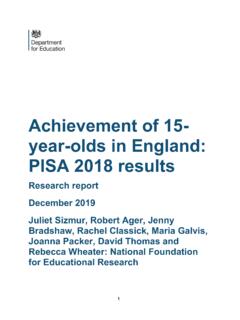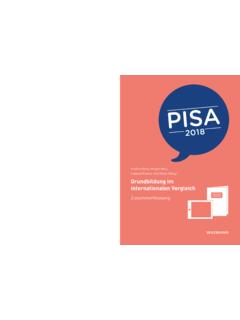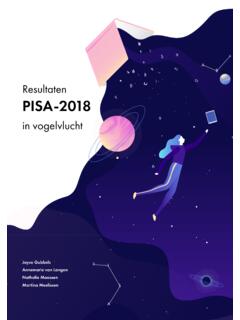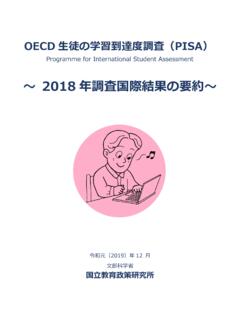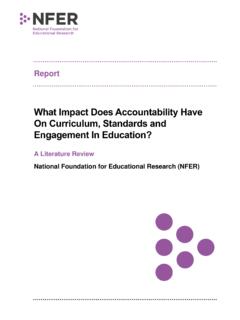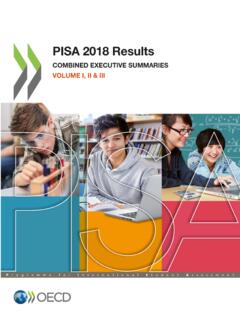Transcription of PISA 2018 Insights and Interpretations Final PDF - OECD
1 2018 . Insights and Interpretations Andreas Schleicher PISA 2018 : Insights and Interpretations . Equipping citizens with the knowledge and skills necessary to achieve their full potential, to contribute to an increasingly interconnected world, and to convert better skills into better lives needs to become a more central preoccupation of policy makers around the world. Fairness, integrity and inclusiveness in public policy thus all hinge on the skills of citizens. In working to About PISA. achieve these goals, more and more countries are Up to the end of the 1990s, the OECD's comparisons might remember enough to follow in our footsteps;. of education outcomes were mainly based on but if they learn how to learn, and are able to think looking beyond their own borders for evidence measures of years of schooling, which are not reliable for themselves, and work with others, they can go indicators of what people actually know and can do.
2 Anywhere they want. of the most successful and efficient education The Programme for International Student Assessment (PISA) changed this. The idea behind PISA lay in Some people argued that the PISA tests are unfair, policies and practices. testing the knowledge and skills of students directly, because they may confront students with problems they through a metric that was internationally agreed upon; have not encountered in school. But then life is unfair, linking that with data from students, teachers, schools because the real test in life is not whether we can and systems to understand performance differences; remember what we learned at school, but whether we PISA is not only the world's most comprehensive will be able to solve problems that we can't possibly and then harnessing the power of collaboration to act on the data, both by creating shared points of anticipate today.
3 And reliable indicator of students' capabilities, it is reference and by leveraging peer pressure. But the greatest strength of PISA lies in its working also a powerful tool that countries and economies The aim with PISA was not to create another layer methods. Most assessments are centrally planned and of top-down accountability, but to help schools and then contracted to engineers who build them. That's can use to fine-tune their education policies That policy makers shift from looking upward within the how tests are created that are owned by a company education system towards looking outward to the next but not by the people who are needed to change is why the OECD produces this triennial report on teacher, the next school, the next country. In essence, education.
4 PISA turned that on its head. The idea of PISA counts what counts, and makes that information PISA attracted the world's best thinkers and mobilised the state of education around the globe: to share available to educators and policy makers so they can hundreds of experts, educators and scientists from the make more informed decisions. participating countries to build a global assessment. Today, we would call that crowdsourcing; but evidence of the best policies and practices, and The OECD countries that initiated PISA tried to whatever we call it, it created the ownership that was make PISA different from traditional assessments in critical for success. to offer our timely and targeted support to help other ways too. In a world that rewards individuals increasingly not just for what they know, but for what In a nutshell, PISA owes its success to a collaborative countries provide the best education possible for they can do with what they know, PISA goes beyond effort between the participating countries, the national.
5 Assessing whether students can reproduce what they and international experts and institutions working within all of their students. have learned in school. To do well in PISA, students the framework of the PISA Consortium, and the OECD. have to be able to extrapolate from what they Subject-matter experts, practitioners and policy makers know, think across the boundaries of subject-matter from the participating countries worked tirelessly to disciplines, apply their knowledge creatively in novel build agreement on which learning outcomes are Angel Gurr a situations and demonstrate effective learning strategies. important to measure and how to measure them best;. OECD Secretary-General If all we do is teach our children what we know, they to design and validate assessment tasks that can reflect OECD 2019 3.
6 PISA 2018 : Insights and Interpretations . Equipping citizens with the knowledge and skills necessary to achieve their full potential, to contribute to an increasingly interconnected world, and to convert better skills into better lives needs to become a more central preoccupation of policy makers around the world. Fairness, integrity and inclusiveness in public policy thus all hinge on the skills of citizens. In working to About PISA. achieve these goals, more and more countries are Up to the end of the 1990s, the OECD's comparisons might remember enough to follow in our footsteps;. of education outcomes were mainly based on but if they learn how to learn, and are able to think looking beyond their own borders for evidence measures of years of schooling, which are not reliable for themselves, and work with others, they can go indicators of what people actually know and can do.
7 Anywhere they want. of the most successful and efficient education The Programme for International Student Assessment (PISA) changed this. The idea behind PISA lay in Some people argued that the PISA tests are unfair, policies and practices. testing the knowledge and skills of students directly, because they may confront students with problems they through a metric that was internationally agreed upon; have not encountered in school. But then life is unfair, linking that with data from students, teachers, schools because the real test in life is not whether we can and systems to understand performance differences; remember what we learned at school, but whether we PISA is not only the world's most comprehensive will be able to solve problems that we can't possibly and then harnessing the power of collaboration to act on the data, both by creating shared points of anticipate today.
8 And reliable indicator of students' capabilities, it is reference and by leveraging peer pressure. But the greatest strength of PISA lies in its working also a powerful tool that countries and economies The aim with PISA was not to create another layer methods. Most assessments are centrally planned and of top-down accountability, but to help schools and then contracted to engineers who build them. That's can use to fine-tune their education policies That policy makers shift from looking upward within the how tests are created that are owned by a company education system towards looking outward to the next but not by the people who are needed to change is why the OECD produces this triennial report on teacher, the next school, the next country. In essence, education.
9 PISA turned that on its head. The idea of PISA counts what counts, and makes that information PISA attracted the world's best thinkers and mobilised the state of education around the globe: to share available to educators and policy makers so they can hundreds of experts, educators and scientists from the make more informed decisions. participating countries to build a global assessment. Today, we would call that crowdsourcing; but evidence of the best policies and practices, and The OECD countries that initiated PISA tried to whatever we call it, it created the ownership that was make PISA different from traditional assessments in critical for success. to offer our timely and targeted support to help other ways too. In a world that rewards individuals increasingly not just for what they know, but for what In a nutshell, PISA owes its success to a collaborative countries provide the best education possible for they can do with what they know, PISA goes beyond effort between the participating countries, the national.
10 Assessing whether students can reproduce what they and international experts and institutions working within all of their students. have learned in school. To do well in PISA, students the framework of the PISA Consortium, and the OECD. have to be able to extrapolate from what they Subject-matter experts, practitioners and policy makers know, think across the boundaries of subject-matter from the participating countries worked tirelessly to disciplines, apply their knowledge creatively in novel build agreement on which learning outcomes are Angel Gurr a situations and demonstrate effective learning strategies. important to measure and how to measure them best;. OECD Secretary-General If all we do is teach our children what we know, they to design and validate assessment tasks that can reflect OECD 2019 3.










